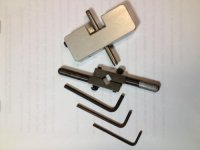Back when I started turning necks, it was pretty much all for .22 and 6mm calibers (still is), so I collected a bag of .222 cases(because I have FL dies for that caliber) that had been left behind by various shooters at the range, and over the years I have used those cases to set up neck turners, resizing and expanding for various .22 caliber applications, and expanding up for 6mm. That way I have avoided making mistakes on cases that were intended for shooting. I never use "range brass" for anything else, although I would use once fired if it came from the same lot, if it were available that way. Currently, I have been using a 21st Century driver (that I prefer to the K&M) to turn cases with an old Makita cordless drill, with the gears set for low speed. I have a couple of those old Sinclair turners, and although my carbide mandrels fit my K&M turner, I believe that Sinclair offers carbide mandrels that will fit your turner. If you are going to do much turning, I think that you should consider the upgrade. There is nothing wrong with these old turners, except they can be a little touchy when trying to tune neck thickness to the ten thousandth. Practice with some discarded brass should teach you how to do that, although I will admit to overshooting my mark on occasion. Any time that I am adjusting the cutter on a turner I put a little tension on its lock screw, so that the cutter can still be pushed by the adjustment screw, and it will stay where you put it. After I know that the setting is what I want, I tighten it a little more, to make it secure. Obviously turners that use different adjustment systems would be handled differently. Back in '99 or so, I did some product writing for Shooters News magazine, that included a Holland neck mic. that I still have, and I have always had a one inch mic. that reads to .0001 (well nearly always) and find these tools indispensable. It takes some practice to read a mic to .0001, especially on brass. Because any cutter will leave some small amount of ridging on the outside of a neck, as a last step, before I measure, I spin the neck in a wad of 0000 steel wool for a few seconds, with pressure from my thumb and index finger to smooth things out a bit. There are some other tricks that I have found useful. PM me if you like for further discussion.
Boyd


